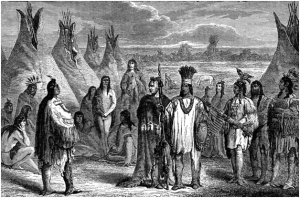Sometime in Creek Tribe History 1700’s, the Creek Confederacy that was comprised of the Alabama land north of what now called today as Stockton, with the heart of the Creek Nation unified along the intersection of the Coosa and Tallapoosa Rivers that are near in Montgomery. The Poarch Creek Indians dynasties had settled along the Alabama River, as well as the areas from the Wetumpka south to the habitat of Tensaw.
Creek Tribe History
According to Creek Tribe History during 1790, a Treaty of New York was approved. The treaty was used so that the Creeks would approve the U.S. government to use and enhance the Indian trails or roads through Alabama to take lead the American settlement following the Louisiana Purchase. After the treaty was declared and certified, the Creeks had permission to start their businesses along the Indian Trail to be of service to the settlers that were passing along the Indian Territory. Weeks passed and it was being enhanced through widening it and it became the Federal Road.

Some of the ancestors of the Poarch Creeks relocated down the Alabama River just to meet the demand for these essential services to the young American Government. In other words, they were somehow helping the American government at that time. These Creeks were considered to be the friendly ones. They named them as the “Friendly Creeks”. These Friendly Creeks had signed a contract with the American federal government for them to become tour guides, interpreters, ferrymen and river pilots for those people who were
Creeks Government
These Friendly Creeks had signed a contract with the American federal government for them to become tour guides, interpreters, ferrymen and river pilots for those people who were traveling using the Territory of the Creeks. They also run some inns that can accommodate the travelers and raised free-range cattle as well. These Creek people who have established this kind of businesses bought land just along the Alabama River from Tensaw to Claiborne and eastward along the Little River.
Many travelers who were passing through the Indian Territory had grown its number each day. Some of this growing number decided to live and settled in the Indian land. The friendly Creeks and the hostile Creeks had increased their tension with each other towards the U.S. government. A final war had resulted in 1813 when there was a military fight at the Burnt Corn and a vengeful attack at Fort Mims. During this battle, the Creek Nation had been defeated at Horseshoe Bend. A year after the battle, it was 1814 when a man named Andrew Jackson commanded the Fort Toulouse and was renamed it as Fort Jackson, after the last name of Andrew, signed the Treaty of Fort Jackson. This treaty was made and
About Creek Nation
During this battle, the Creek Nation had been defeated at Horseshoe Bend. A year after the battle, it was 1814 when a man named Andrew Jackson commanded the Fort Toulouse and was renamed it as Fort Jackson, after the last name of Andrew, signed the Treaty of Fort Jackson. This treaty was made and resulted in the Creeks to be forced to surrender their land to the United States and was transported under duress from their area in Alabama.
In spite of the transferring of some Southeastern Indians to the land named Oklahoma, there were still Creeks families in the Tensaw community just because they had given and provided services including the Manac, Hollinger, Sizemore, Stiggins, Bailey, Colbert, and Weatherford. They had been given a permission to remain in their land. Some others, like the Semoice and Lynn McGhee, had been unlucky since they had not able to file their land selections beforehand. However, in the year 1836, a special act of Congress was signed and let the Lynn McGhee, Semoice, Susan Marlow and Samuel Smith to have their own permitted land.